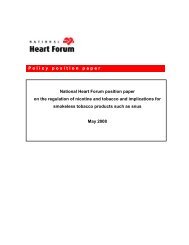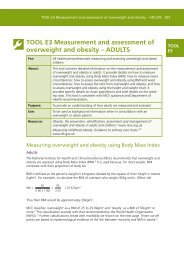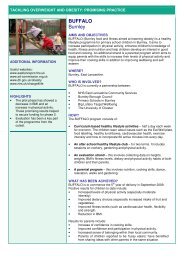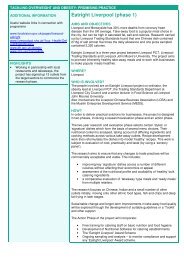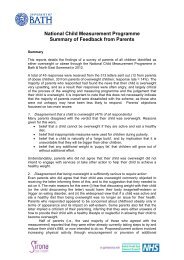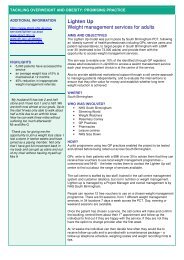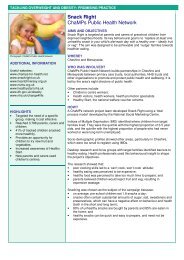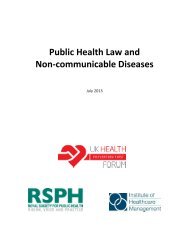The Challenge of Non-Communicable Diseases and Road Traffic ...
The Challenge of Non-Communicable Diseases and Road Traffic ...
The Challenge of Non-Communicable Diseases and Road Traffic ...
Create successful ePaper yourself
Turn your PDF publications into a flip-book with our unique Google optimized e-Paper software.
An Overview 25<br />
TABLE 5: Prevalence <strong>of</strong> Weekly Heavy Drinking Episodes among Drinkers in the Past 12 Months by Sex –<br />
WHO Region <strong>and</strong> the World, 2005<br />
WHO region Women (%) Men (%) Average Total (%)<br />
Africa 16.2 30.5 25.1<br />
Americas 4.5 17.9 12.0<br />
Eastern Mediterranean 17.9 24.9 24.7<br />
Europe 4.6 16.8 11.0<br />
South-East Asia 12.9 23.0 21.7<br />
Western Pacific 1.3 11.6 8.0<br />
WORLD 4.2 16.1 11.5<br />
Source: [97]<br />
region abstain from alcohol, those that do drink do<br />
so in a harmful way that increases risk particularly<br />
<strong>of</strong> acute consequences: almost two-thirds <strong>of</strong> the alcohol-attributable<br />
disease burden relates to injuries<br />
[6], <strong>and</strong> heavy-episodic drinking is linked with unsafe<br />
sex leading to STIs <strong>and</strong> HIV transmission [98].<br />
<strong>The</strong> presence <strong>of</strong> alcohol as a contributory factor to<br />
road crashes is likely to be under-reported in Africa,<br />
due to lack <strong>of</strong> detection technology, <strong>and</strong> unspecified<br />
reporting, due to limited use <strong>of</strong> st<strong>and</strong>ard codification,<br />
logistics, <strong>and</strong> enforcement. Nevertheless, a<br />
study in Nigeria over the period 1996-2000 found<br />
alcohol to be a factor in 50 percent <strong>of</strong> police report<br />
accidents [99].<br />
<strong>The</strong>re is a strong relationship between economic<br />
wealth <strong>and</strong> alcohol consumption for low-income<br />
countries: as GDP rises, the overall volume that is<br />
consumed increases, <strong>and</strong> the proportion <strong>of</strong> abstainers<br />
decreases [73]. Consumption <strong>of</strong> commercially-produced<br />
alcohol is expected to rise as economic<br />
conditions improve in African countries [100]; while<br />
other regions have experienced stable consumption<br />
trends, an increase has been noted in the African<br />
<strong>and</strong> Southeast Asian regions. With Western markets<br />
more or less saturated, low-income countries<br />
<strong>and</strong> emerging markets with large populations such<br />
as South Africa <strong>and</strong> Nigeria, <strong>and</strong> even Malawi <strong>and</strong><br />
Ug<strong>and</strong>a, are being targeted by global alcohol corporations<br />
[101]. Adolescents <strong>and</strong> young adults are<br />
a particular target, for example through sponsorship<br />
<strong>of</strong> sports [96].<br />
Physical Activity <strong>and</strong> Travel<br />
Overall physical activity levels are relatively high<br />
in Africa, with most either work-related or transport-related.<br />
This is especially so in rural areas, but<br />
levels <strong>of</strong> physical inactivity have been shown to rise<br />
with urbanization [102-104].<br />
In most African cities, most residents walk or<br />
use public transportation for daily routine activities.<br />
Cycling is usually negligible in large cities, but<br />
may reach 20 percent <strong>of</strong> daily journeys in smaller<br />
cities [105]. Poor law enforcement combined with<br />
poor road infrastructure, <strong>and</strong> high traffic mix <strong>and</strong><br />
little separation <strong>of</strong> vulnerable road users from high<br />
speed motorized traffic, contribute to the high rate<br />
<strong>of</strong> crashes <strong>and</strong> fatalities [59]. A poorly-regulated<br />
private sector may be the major supplier <strong>of</strong> public<br />
transport, <strong>and</strong> the risk to passengers <strong>of</strong> collision<br />
<strong>and</strong> injury involving public buses is increased by<br />
lack <strong>of</strong> seat belts, overcrowding, <strong>and</strong> hazardous road<br />
environments: in Ghana, the majority (58 percent)<br />
<strong>of</strong> crashes in urban areas involved buses <strong>and</strong> minibuses,<br />
with most <strong>of</strong> those injured being their passengers<br />
or pedestrians [63, 106].<br />
3.2. Drivers <strong>of</strong> NCD Trends<br />
Growing Urbanization<br />
SSA is urbanizing faster than any other continent,<br />
<strong>and</strong> in the Northern <strong>and</strong> Southern sub-regions over<br />
half the total population already live in urban agglomerations<br />
[107]. Rapidly-growing cities can be



